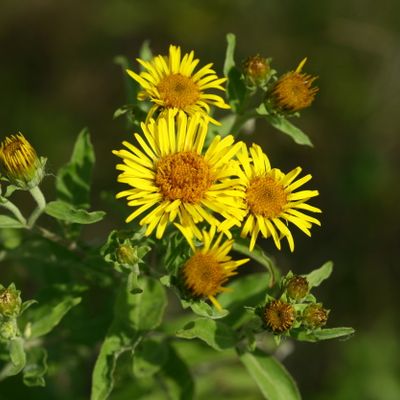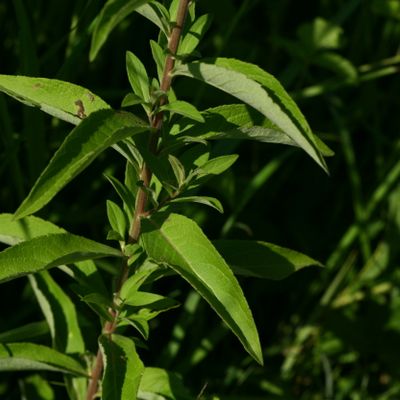Inula helvetica Weber
1024510
Species
ISFS : 214500
Checklist : 1024510
ISFS : 214500
Checklist : 1024510
Contains :
Synthesis
Species description (© Flora Helvetica 2018)
50-150 cm hoch, oben meist verzweigt, nach Melisse duftend. Stängel dicht behaart. Blätter lanzettlich, fein gezähnt oder ganzrandig, unterseits grauhaarig, untere kurz gestielt, obere mit verschmälertem Grund sitzend. Blüten gelb. Köpfe in einer lockeren, doldigen Rispe, Durchmesser 2,5-3 cm. Zungenblüten abstehend, ca. 1 mm breit. Früchte ca. 2 mm, Pappus 5-6 mm lang.Flowering period (© Flora Helvetica 2018)
7-8Habitat and distribution inside Switzerland (© Flora Helvetica 2018)
Ufergebüsche, Waldränder / kollin / M, vereinzelt AWorld distribution (© Flora Helvetica 2018)
SüdwesteuropäischEcological indicator (© Landolt & al. 2010)
4w+42-34+2.h.2n=?Status
IUCN status
VulnerableNational Priority
2 - high national priorityInternational responsibility
3 - highConservation
Threats
Starke Verbuschung, Sukzession
Bautätigkeit (Strassen, Deponien, Industrie, Tourismus)
Invasive Arten (Goldruten, Adlerfarn aber auch Brombeeren)
Eingriffe in den Wasserhaushalt (Grundwasserabsenkungen, Entwässerungen, Flusskorrekturen, Meliorationen)
Änderung des Basen- und Nährstoffgehalts (zu starke Eutrophierung)
Distribution map
Habitat and distribution inside Switzerland
M, vereinzelt AWorld distribution
SüdwesteuropäischEcology
Life form
Perennial hemicryptophyte
Habitats
Milieux Phytosuisse (© Prunier et al. 2017)
Habitats © Delarze & al. 2015
 | 5.1.3 - Feuchter Krautsaum (Tieflagen) (Convolvulion) |
bold
Dominant species, influencing the appearance of the habitat
 Character species
Character species
 Less strictly linked to a specific habitat
Less strictly linked to a specific habitat
Ecological indicator values by © Landolt & al. (2010)
| Soil factors | Climatic factors | Salinity tolerance | |||
|---|---|---|---|---|---|
| Humidity Value H | 4w+ | Light Value L | 3 | Salinity Index | -- |
| Reaction Value R | 4 | Temperature factor T | 4+ | ||
| Nutriments value N | 2 | Continentality K | 2 | ||
- Ecological values legend
Humidity Value H 1 very dry 1+ dry 2 moderatly dry 2+ moist 3 medium wet 3+ wet 4 very wet 4+ soggy 5 submerged or underwater f plants living in running water u mostly submerged plants v partly submerged, partly floating plants w humidity moderately variable (± scale of 1-2) w+ highly variable humidity (scale exceeding ± 2) Reaction Value R 1 Very acid (pH 2.5-5.5) 2 acid (pH 3.5-6.5) 3 lightly acid to neutral (pH 4.5-7.5) 4 neutral to basic (pH 5.5-8.5) 5 basic (pH 6-5 -> 8.5 Nutriments value N 1 very low in nutrients 2 low in nutriments 3 medium-poor to medium-rich in nutrients 4 rich in nutriments 5 very rich in nutriments Salinity tolerance 1 halotolerant 3 halophyle Light Value L 1 very shady 2 shady 3 lighted areas 4 luminous 5 highly luminous Temperature factor T 1 alpine to nival stages (from the treeline to the snowline) 1+ suprasubalpine and upper subalpine levels (pine and larch forests) 2 subalpine level (coniferous forests without beeches up to the upper limit of spruces) 2+ lower subalpine and upper mountain stages 3 mountain level (beech and silver fir forests, in the central Alps Scots pine forests) 3+ lower mountain and upper hill levels 4 hill level (mixed deciduous oak forests) 4+ hot places, hill level 5 very hot places, hill level (only in the hottest places, typical of southern Europe) Continentality K 1 Atlantic (high air humidity, very low temperature variations, mild winters) 2 Sub-Atlantic (high air humidity, low temperature variations, relatively mild winters) 3 sub-Atlantic to subcontinental (average air humidity, moderately variable temperature, slightly low winter temperatures) 4 subcontinental (low air humidity, large temperature variations, rather cold winters) 5 continental (very low air humidity, very large temperature variations, cold winters)
Water dependency
| Rivers | 1 - Secondary habitat |
| Calm water | 1 - Secondary habitat |
| Ground water | 0 - No link |
Nomenclature
Accepted Name (Checklist 2017)
Inula helvetica Weber
Vernacular name
Deutscher Name :
Schweizer AlantNom français :
Inule de SuisseNome italiano :
Enula svizzeraMatch with other reference books
| Relation | Nom | Book | No |
|---|---|---|---|
| = | Inula helvetica Weber | Checklist 2017 | 214500 |
| = | Inula helvetica Weber | Flora Helvetica 2001 | 2081 |
| = | Inula helvetica Weber | Flora Helvetica 2012 | 2071 |
| = | Inula helvetica Weber | Flora Helvetica 2018 | 2071 |
| = | Inula helvetica Weber | Index synonymique 1996 | 214500 |
| = | Inula helvetica Weber | Landolt 1977 | 3128 |
| = | Inula helvetica Weber | Landolt 1991 | 2513 |
| = | Inula helvetica Weber | SISF/ISFS 2 | 214500 |
| = | Inula helvetica Weber | Welten & Sutter 1982 | 1758 |
= The taxon corresponds to the accepted taxon (Checklist 2017)
< The taxon is included in the accepted taxon (Checklist 2017)
> The taxon includes (among others) also the accepted taxon (Checklist 2017)
< The taxon is included in the accepted taxon (Checklist 2017)
> The taxon includes (among others) also the accepted taxon (Checklist 2017)
Status
Native status
-IUCN list of endangered species (© Walter & Gillett 1997) : Yes
Status on national Red List 2016
IUCN status:
Vulnerable

Additional information
IUCN criteria: C2a(i)
Status on regional Red List 2019
| Biogregraphic regions | Status | IUCN criteria |
|---|---|---|
| Jura (JU) | VU | C2a(i) |
| Mittelland (MP) | VU | C2a(i) |
| Alpennordflanke (NA) | EN | A3c; C2a(i) |
| Alpensüdflanke (SA) | -- | |
| Östliche Zentralalpen (EA) | -- | |
| Westliche Zentralalpen (WA) | -- |
- Legend
EX Extinct RE Regionally Extinct CR(PE) Critically Endangered, Probably Extinct CR Critically Endangered EN Endangered VU Vulnerable NT Near Threatened LC Least Concern DD Data Deficient NE Not Evaluated NA Not Applicable
National Priority Species List Status
| National Priority | 2 - high national priority |
| Need to take action | 2 - |
| International responsibility | 3 - high |
| Need to monitor populations | 2 - |
Protection status
| International (Bern Convention) | No | |
| GE | total protection | (25.07.2007) |
| TG | total protection | (01.01.2018) |
| VD | total protection | (02.03.2005) |
| Switzerland | total protection | |
| ZG | total protection | (01.10.2013) |
| ZH | partial protection | (03.12.1964) |
- Disclaimer
InfoFlora compiles information on protected species as accurately as possible, taking it from the respective cantonal laws. In some cases, however, it was not possible to use the plant names as listed in the original text, but an interpretation of their taxonomy or nomenclature was necessary. The exact meaning of the categories „completely protected“ and „partially protected“ differs among the cantons.
InfoFlora cannot guarantee that the information on the protection status is correct and complete. In case of doubts, we recommend to look up the texts of the respective cantonal law.
Status by sector of activity
| Agriculture-related environmental objectives : | more informations | |
| Forest management environmental objectives : | - | more informations |
Conservation
Threats and measures
Starke Verbuschung, Sukzession
Periodisches Ausholzen und Entbuschen
Bautätigkeit (Strassen, Deponien, Industrie, Tourismus)
Sorgfältige, auf die Art Rücksicht nehmende Planung bei allfälligen Bauvorhaben
Invasive Arten (Goldruten, Adlerfarn aber auch Brombeeren)
Frühes Bekämpfen der Goldruten (z. T. von Hand)
entfernen der Brombeeren
mehrmaliges Ausreissen aller Adlerfarnsprosse (Auszehrung der Rhizome z. B. bei Affoltern a. A.)
Eingriffe in den Wasserhaushalt (Grundwasserabsenkungen, Entwässerungen, Flusskorrekturen, Meliorationen)
Keine weiteren Eingriffe in den Wasserhaushalt, falls nötig Regulierung des Wasserstandes (durch Unterhalt und Regulierung der bestehenden Rietgräben)
Änderung des Basen- und Nährstoffgehalts (zu starke Eutrophierung)
Verstärkung der Luftreinhaltemassnahmen
grosse Pufferzonen
keine Düngung in der Umgebung

